A walker and prosthetic leg were seen on the road in Enfield, near where Robert Hubbard was fatally struck by a Hyundai Sonata driven by a woman who appears to have not been charged. One news station reported those alarming details. Both driver and victim were 65.
This section of Route 5 has a sidewalk on only one side of the street; there is a painted crosswalk for those trying to get across Broad Leaf Lane, but nothing for crossing the main drag. Hubbard was described as having lived on the street where he was fatally injured.
Just over a week later, Gilberto Molina, age 44, was found critically injured on New Haven’s Columbus Avenue around 8:07 PM. The driver who hit and killed him did not stick around to take responsibility. Although this detail did not make it into any news reports that I have seen, the Connecticut Crash Data Repository describes a ladder being found near Molina.
Was Molina carrying the ladder, did it fall off the vehicle that struck him, or was it a coincidence? If it was the victim’s, then the question becomes: how does a driver not see somebody carrying a ladder? How does a driver not see someone using a walker?
The victim’s family portrayed Molina as a timid man who loved fishing and music, painted nature scenes, and as someone who will be missed.
On February 12, on Dixwell Avenue in Hamden, two men were waiting inside a bus shelter when they were struck by a Jeep driven by 31-year old Pinky McBurrows of Ansonia. After striking them, she continued driving the Jeep for about half a block, on the sidewalk, with flat tires. She opened the door and made an attempt to flee, which was thwarted by police. (Initially, some news outlets reported that the driver remained on the scene, which I suppose is technically accurate, but exceedingly misleading given the circumstances) Both men were injured, Maurice Messier, age 57, fatally. The driver was charged with reckless driver, evading responsibility, operating without a license, and failure to drive in the proper lane.
Calling these men pedestrians does not seem accurate. They were not in the roadway. They were not even walking on the sidewalk. They were inside a bus shelter, in a place where one would not expect to have to dodge a vehicle.
The following day, 79-year old Daniel Paine was reportedly pinned under a vehicle after stepping outside of his condo in Avon. Initially, the police did not name who drove the vehicle.
The victim was described in his obituary as having a happy childhood and later serving as a captain in the Air Force. His first marriage ended amicably after 30 years. He started his own business: construction work site safety consulting, and at one time participated in a study on ironworker fatalities.
In Rocky Hill on February 17th, Thomas Caruso was hit on New Britain Avenue near Trinity Ridge at 4:37 PM by a driver who has not been named and who remained on the scene. He died later in the hospital. There has been no mention of charges the driver could face, and his death was only made public on February 29th.
On the 23rd, another driver hit and killed another pedestrian. This time, the victim was a 68-year old New Haven man — Govinda Kandel — who died on the city’s Middletown Avenue by Cross Street.
Maybe you’ve noticed that in this series, we are talking about humans. Six humans died in February in Connecticut after being struck by vehicles that were driven by other humans. This is a total of 14 pedestrians, year-to-date, statewide.
Words matter.
When it comes to traffic violence, it’s time to call it what it is. To paraphrase Mark Rosekind, God does not cause crashes, so stop calling them accidents.
What does cause collisions? Select one or more: recklessness, speeding, a person piloting an automobile while distracted, casual carelessness, malice, impairment due to alcohol or other substance use, poor vision, driving too fast for weather or road conditions, failure to yield, driving too fast for poor lighting conditions, not looking both ways before turning right on red, not looking.
A driver may not have intended to maim or kill somebody crossing the street, but the driver’s actions had this result, nonetheless.
I am not anywhere near the first to point out that “accident” is the wrong word to use. This conversation has been building in recent years, and anyone with half a brain can tell this is not a matter of silly semantics.
The American Association for the Advancement of Science (AAAS), in 2016, quoted U.S. Supreme Court Justice Elena Kagan to point out something about the word accident: “Reckless conduct, which requires the conscious disregard of a known risk, is not an accident: It involves a deliberate decision to endanger another.” In this case, Kagan was referring to guns, and AAAS was making a point about lab safety, but the link to road safety is obvious.
Others have already mentioned how we speak of plane crashes, but never plane accidents — why should cars be any different?
Reporters should know better. Their profession requires them to ask questions, including of those in positions of authority, like the police. Parroting whatever the police post on Twitter or say over the scanner is irresponsible and lazy. Reporters may not have malicious intent, but mindless use of language is no accident either.
And yet, in 2020, I am still reading news reports in which the authors have performed verbal gymnastics to do one thing: make use of that word, accident.
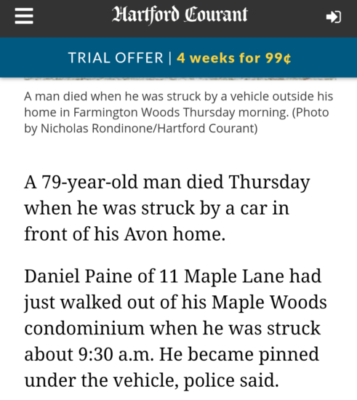
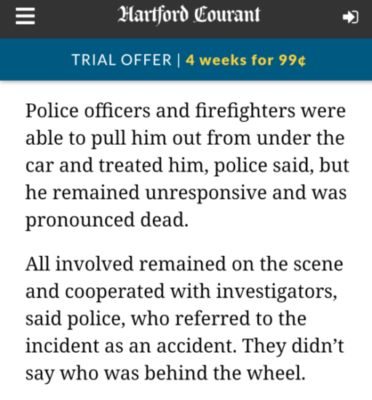
Another account of the same event also made it sound as if the victim was fatally injured by an autonomous vehicle.
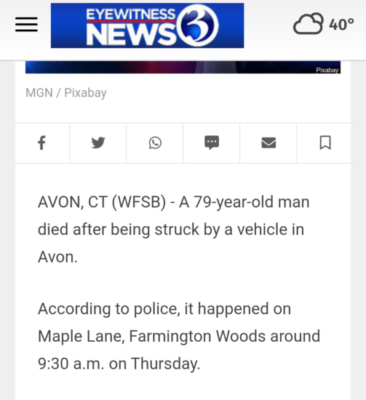
Later it would be revealed that this individual was struck by a vehicle that his wife was operating. There are ways to be gentle with language without obscuring cause and effect.
Far more egregious, though, was a few days later when the New Haven Register used this language:
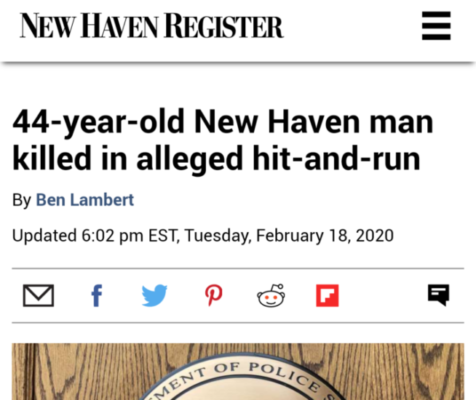
Gilberto Molina was found in the street. The driver did not stay on the scene to take any responsibility for his or her actions. I fail to see why the word “alleged” would be used.
In another case of “did they seriously write that,” WTNH made it sound as if an autonomous vehicle was what slammed into a bus shelter, striking two men in Hamden.
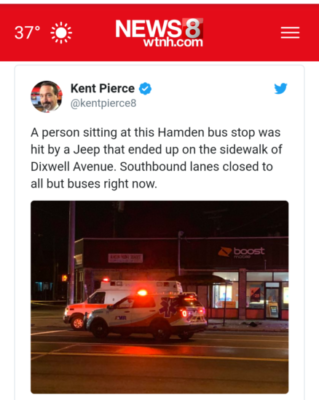
An accident suggests that the incident was unavoidable. As long as we act as if each of these deaths is inevitable and isolated, we will continue to drag our feet when it comes to making the changes to solve the problem.
Accident, along with passive voice, deflect responsibility. It exonerates the driver. It’s not a neutral term. It acts as a linguistic evasion. There have been studies showing language impacts ideas about blame and punishment.
Tara Goddard’s 2019 study published in Transportation Research Interdisciplinary Perspectives spells out how reporters can improve on current norms, and how language impacts perspective:

According to the CDC, every 90 minutes in the United States, there is a crash-related pedestrian death. This year alone, 14 pedestrians in Connecticut have been killed in crashes. This is a public health issue; injuries and deaths are preventable, not inevitable. Let’s use language that reflects this fact.
Thankfully, some reporters can handle reporting with accuracy. You can find them at New Haven Independent.
Not a reporter?
You can educate reporters and others about how to use more accurate language when spreading the news and you can tell your State Representative that more needs to be done to protect vulnerable road users, AKA pedestrians AKA people.
Below: map of Connecticut’s pedestrian fatalities in 2020
Featured Image: Screenshot from MichiganDOT video Crash, Not Accident
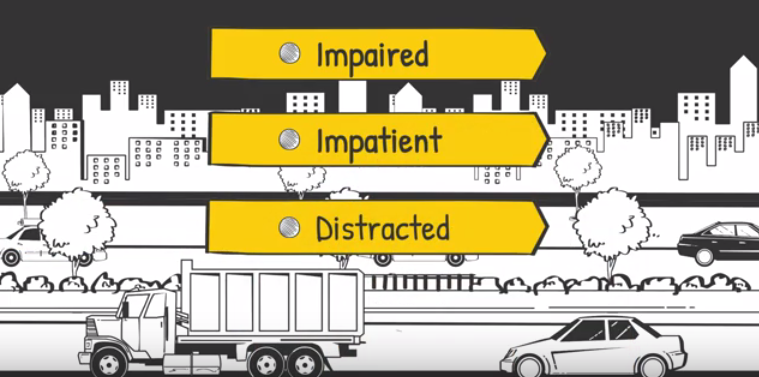
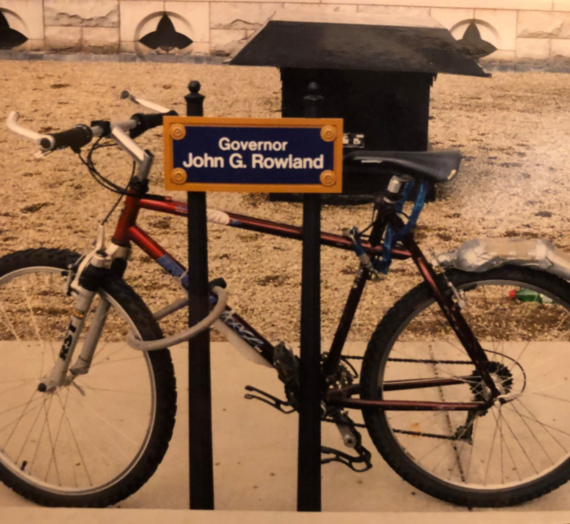

Let Them Eat Hi-Vis – Real Hartford
[…] have been struck and killed (or critically injured) by cars while waiting for the bus and being in a courthouse’s parking lot. Nobody in their right mind would suggest to them, or […]